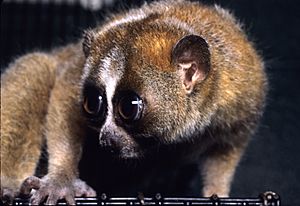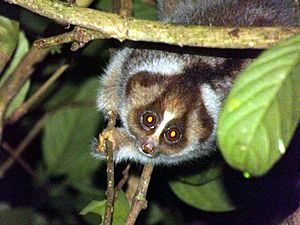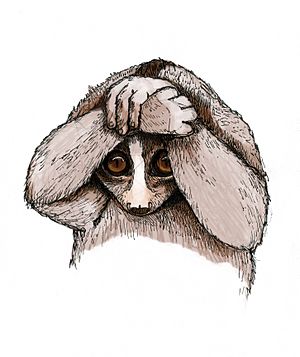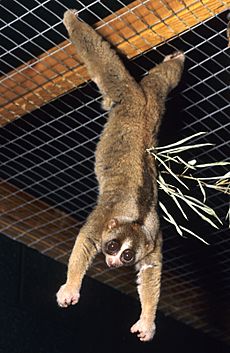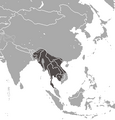Slow loris facts for kids
Quick facts for kids Slow lorises |
|
|---|---|
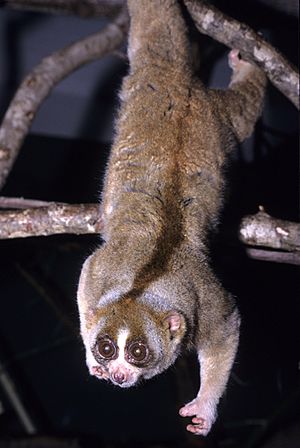 |
|
| Sunda slow loris Nycticebus coucang | |
| Conservation status | |
| Scientific classification |
|
| Kingdom: | Animalia |
| Phylum: | Chordata |
| Class: | Mammalia |
| Order: | Primates |
| Suborder: | Strepsirrhini |
| Family: | Lorisidae |
| Subfamily: | Lorinae |
| Genus: | Nycticebus É. Geoffroy, 1812 |
| Type species | |
| Tardigradus coucang Boddaert, 1785
|
|
| Species | |
|
|
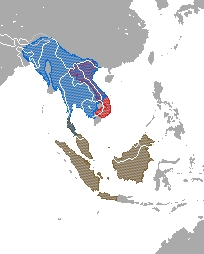 |
|
| Distribution of Nycticebus and Xanthonycticebus red = X. pygmaeus; blue = N. bengalensis; brown = N. bancanus, N. borneanus, N. coucang, N. javanicus, N. kayan & N. menagensis | |
| Synonyms | |
|
|
Slow lorises are a group of several species of nocturnal strepsirrhine primates that make up the genus Nycticebus.
Contents
Distribution
Slow lorises are found in Southeast Asia and bordering areas. They range from Bangladesh and Northeast India in the west to the Sulu Archipelago in the Philippines in the east, and from Yunnan province in China in the north to the island of Java in the south.
Slow lorises range across tropical and subtropical regions and are found in primary and secondary rainforests, as well as bamboo groves and mangrove forests. They prefer forests with high, dense canopies, although some species have also been found in disturbed habitats, such as cacao plantations and mixed-crop home gardens.
Spicies
Although many previous classifications recognized as few as a single all-inclusive species, there are now at least eight:
- the Sunda slow loris (N. coucang),
- Bengal slow loris (N. bengalensis),
- Javan slow loris (N. javanicus),
- Philippine slow loris (N. menagensis),
- Bangka slow loris (N. bancanus),
- Bornean slow loris (N. borneanus),
- Kayan River slow loris (N. kayan) and
- Sumatran slow loris (N. hilleri).
A ninth species, the pygmy slow loris (X. pygmaeus), was recently moved to the new genus Xanthonycticebus.
Each of the slow loris species that had been identified prior to 2012 is listed as either "Vulnerable" or "Endangered" on the IUCN Red List.
Related spicies
After the pygmy slow loris, the group's closest relatives are the slender lorises of southern India and Sri Lanka. Their next closest relatives are the African lorisids, the pottos, false pottos, and angwantibos. They are less closely related to the remaining lorisoids (the various types of galago), and more distantly to the lemurs of Madagascar. Their evolutionary history is uncertain since their fossil record is patchy and molecular clock studies have given inconsistent results.
Discovery
The earliest known mention of a slow loris in scientific literature is from 1770, when Dutchman Arnout Vosmaer (1720–1799) described a specimen of what we know today as N. bengalensis that he had received two years earlier.
The word "loris" was first used in 1765 by the French naturalist Georges-Louis Leclerc, Comte de Buffon as a close equivalent to a Dutch name, loeris. This etymology was later supported by the physician William Baird in the 1820s, who noted that the Dutch word loeris signified "a clown".
Description
Slow lorises have a round head, a narrow snout, large eyes, and a variety of distinctive coloration patterns. Their arms and legs are nearly equal in length, and their torso is long and flexible. This allows them to twist and extend to nearby branches.
The hands and feet of slow lorises have a pincer-like grip and enable them to grasp branches for long periods of time. Slow lorises have a toxic bite, a trait rare among mammals and unique among the primates. The toxin is obtained by licking a sweat gland on their arm, and the secretion is activated by mixing with saliva. Their toxic bite, once thought to be primarily a deterrent to predators, has been discovered to be primarily used in disputes within the species.
The eyes of slow lorises are forward-facing, which gives stereo vision. They have good low-light vision. Slow lorises have monochromatic vision, meaning they see in shades of only one color. They lack the opsin gene that would allow them to detect the colors blue and green.
Slow lorises range in weight from the Bornean slow loris at 265 grams (9.3 oz) to as much as 2,100 grams (74 oz) for the Bengal slow loris. Slow lorises have stout bodies, and their tails are only stubs and hidden beneath the dense fur.
Behaviour
Slow lorises move slowly and deliberately, making little or no noise. When threatened, they stop moving and remain motionless. They are nocturnal animals, meaning that they are most active at night.
Little is known about their social structure, but they are known to communicate by scent marking. Adult males are highly territorial and are aggressive towards other males.
Vocal exchanges and alarm calls are limited. In Indonesia, slow lorises are called malu malu or "shy one" because they freeze and cover their face when spotted.
Predators
Their only documented predators—apart from humans—include snakes, changeable hawk-eagles and orangutans, although cats, viverrids and sun bears are suspected. To protect itself, the slow loris sometimes rubs the venom from its toxic gland on its fur to chemically-defend itself from predators.
Reproduction and lifespan
Slow lorises reproduce slowly, and the infants are initially parked on branches or carried by either parent.
Breeding may be continuous throughout the year. In captive Sunda slow lorises, mating primarily occurs between June and mid-September. Likewise, gestation lasts 185 to 197 days, and the young weigh between 30 and 60 grams (1.1 and 2.1 oz) at birth. Females reach sexual maturity at 18 to 24 months, while males are capable of reproducing at 17 months. However, the fathers become hostile towards their male offspring after 12 to 14 months and will chase them away.
In captivity, they can live 20 or more years.
Diet
They are omnivores, eating insects and other arthropods, small birds and reptiles, eggs, fruits, gums, nectar and other vegetation.
Slow lorises have an unusually slow metabolism, about 40% of the typical value for placental mammals of their size. Probably, that is because they need to eliminate toxic compounds from their food. For example, slow lorises can feed on Gluta bark, which may be fatal to humans.
Slow lorises and humans
Deep-rooted beliefs about the supernatural powers of slow lorises, such as their purported abilities to ward off evil spirits or to cure wounds, have popularized their use in traditional medicine.
In the province of North Sumatra, the slow loris is thought to bring good luck if it is buried under a house or a road. In the same province, slow loris body parts were used to place curses on enemies. In Java, it was thought that putting a piece of its skull in a water jug would make a husband more docile and submissive, just like a slow loris in the daytime. The gall bladder of the Bengal slow loris has historically been used to make ink for tattoos by the village elders in Pursat and Koh Kong Provinces of Cambodia. Loris wine is a traditional Cambodian medicine supposed to alleviate the pain of childbirth, made from a mixture of loris bodies and rice wine.
Local laws prohibiting trade in slow lorises and slow loris products. They are also protected from international commercial trade under Appendix I. Despite these, slow lorises are openly sold in animal markets in Southeast Asia and smuggled to other countries, such as Japan. Due in part to the large eyes that are an adaptation to their nocturnal lifestyle, they have also been popularized as 'cute' pets in viral videos on YouTube. Slow lorises have their teeth cut or pulled out for the pet trade.
Slow lorises are sold locally at street markets but are also sold internationally over the Internet and in pet stores. They are especially popular or trendy in Japan, particularly among women. The reasons for their popularity, according to the Japan Wildlife Conservation Society, are that "they're easy to keep, they don't cry, they're small, and just very cute."
In fact, they make poor pets as they are nocturnal, have specialized diets, are difficult to care for, and often die from infection, blood loss, improper caring and handling or inadequate nutrition.
Conservation
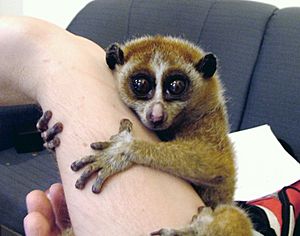
The two greatest threats to slow lorises are deforestation and the wildlife trade. Slow lorises have lost a significant amount of habitat. However, despite the lost habitat, their decline is most closely associated with unsustainable trade, either as exotic pets or for traditional medicine.
Populations of Bengal and Sunda slow lorises are not faring well in zoos. Of the 29 captive specimens in North American zoos in 2008, several are hybrids that cannot breed, while most are past their reproductive years. The last captive birth for these species in North America was in 2001 in San Diego. Pygmy slow lorises are doing better in North American zoos; from the late 1980s (when they were imported) to 2008, the population grew to 74 animals, with most of them born at the San Diego Zoo.
Images for kids
See also
 In Spanish: Nycticebus para niños
In Spanish: Nycticebus para niños


